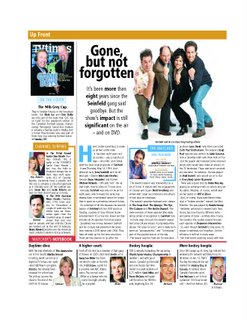
A CHARLIE BROWN CHRISTMAS
TUESDAY; ABC
ALSO DEC. 17 AND 20; YTV (CANADA)
BOTTOM LINE:
A CLASSIC TV TRADITION.
'Tis the season
A Charlie Brown Christmas is still the holiday special by which all others are measured. It didn’t start out that way.
By Eric Kohanik
Maybe it’s a sentimental thing – you know, something you’ve grown up with and still look forward to every year.
Or maybe it’s just the fact that they don’t make ’em like this anymore.
In either case, when it comes to Christmas TV specials, there’s only one that readers ask me about every year: A Charlie Brown Christmas.
Never mind that you can rent or buy the DVD and watch it any time. It’s that traditional over-the-air TV broadcast that still prompts parents to gather the kids around the tube to watch.
It’s comfort television.
It was back on Thursday, Dec. 9, 1965, that viewers got their first look at A Charlie Brown Christmas. And when cartoonist Charles M.Schulz had good ol’ Charlie Brown and the rest of his Peanuts pals seek out the true meaning of Christmas, little did he know that the result would be a holiday special by which all others would be measured.
It’s funny how a mid-1960s saga of a little bald-headed kid and his animated friends still captures everyone’s imagination today. In fact, it didn’t look that way at first.
Network executives at CBS, where the show originated, were mortified by the final product that was delivered to them. They were convinced it would bomb.
The fact that the debut telecast was going to pre-empt Gilligan’s Island didn’t please them, either. Nevertheless, A Charlie Brown Christmas was an instant hit and would become the first of many more Peanuts specials. And, although it may not be the most polished of the bunch, many say it’s the best.
What makes A Charlie Brown Christmas continue to twinkle is more than its simple storyline or its crudely animated characters. Schulz had recruited an American jazz musician named Vince Guaraldi to come up with the soundtrack for the special.
Guaraldi created memorable arrangementsof such songs as Christmas Time Is Here and wrote what would become a signature Peanuts tune, a jazzy little piano number called Linus and Lucy.
As for the TV production itself, that was digitally remastered to spruce it up for a 40th-anniversary telecast last year. The result was a surprisingly vibrant reawakening.
For many years, it was an annual fixture on CBS in the United States and CBC in Canada. That all changed a few years ago, when ABC managed to grab the broadcast rights in the U.S., while YTV snagged the Canadian ones.
This year, viewers will actually have several chances to catch A Charlie Brown Christmas. ABC rolls out its telecast Tuesday night. YTV will wait a little longer, airing it Dec. 17 and then again on the 20th.
And, of course, there’s always the DVD.



